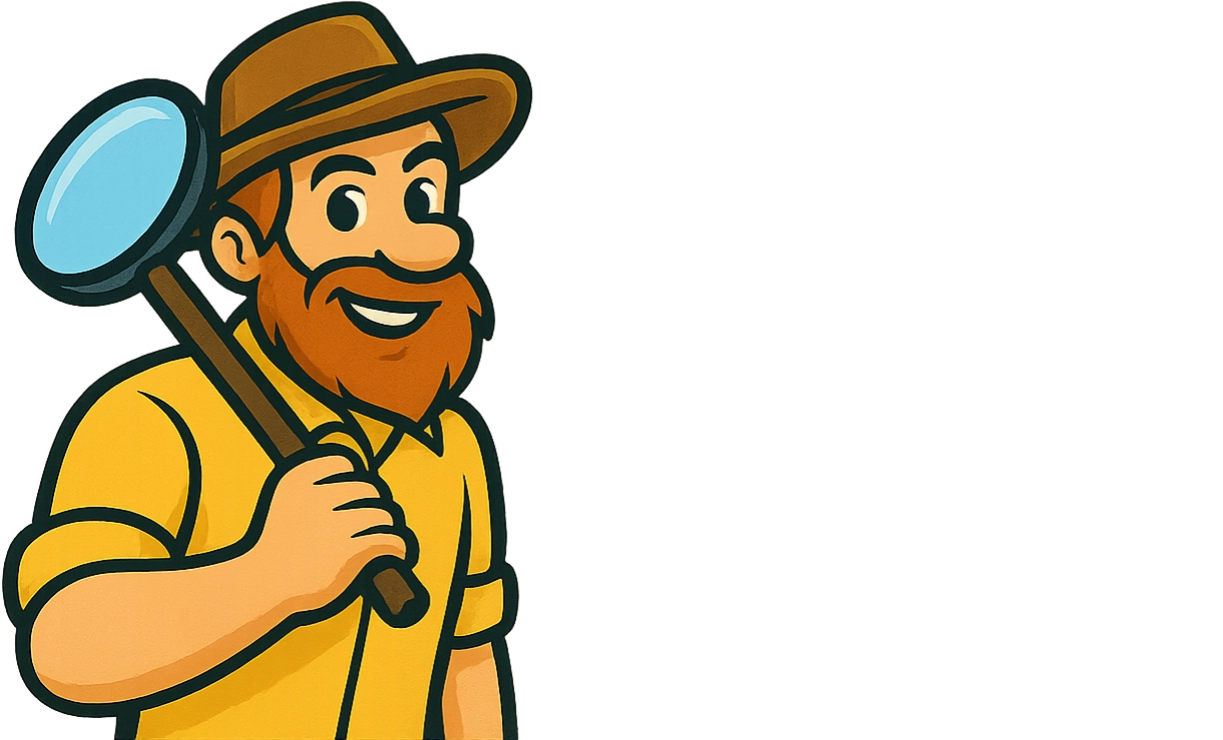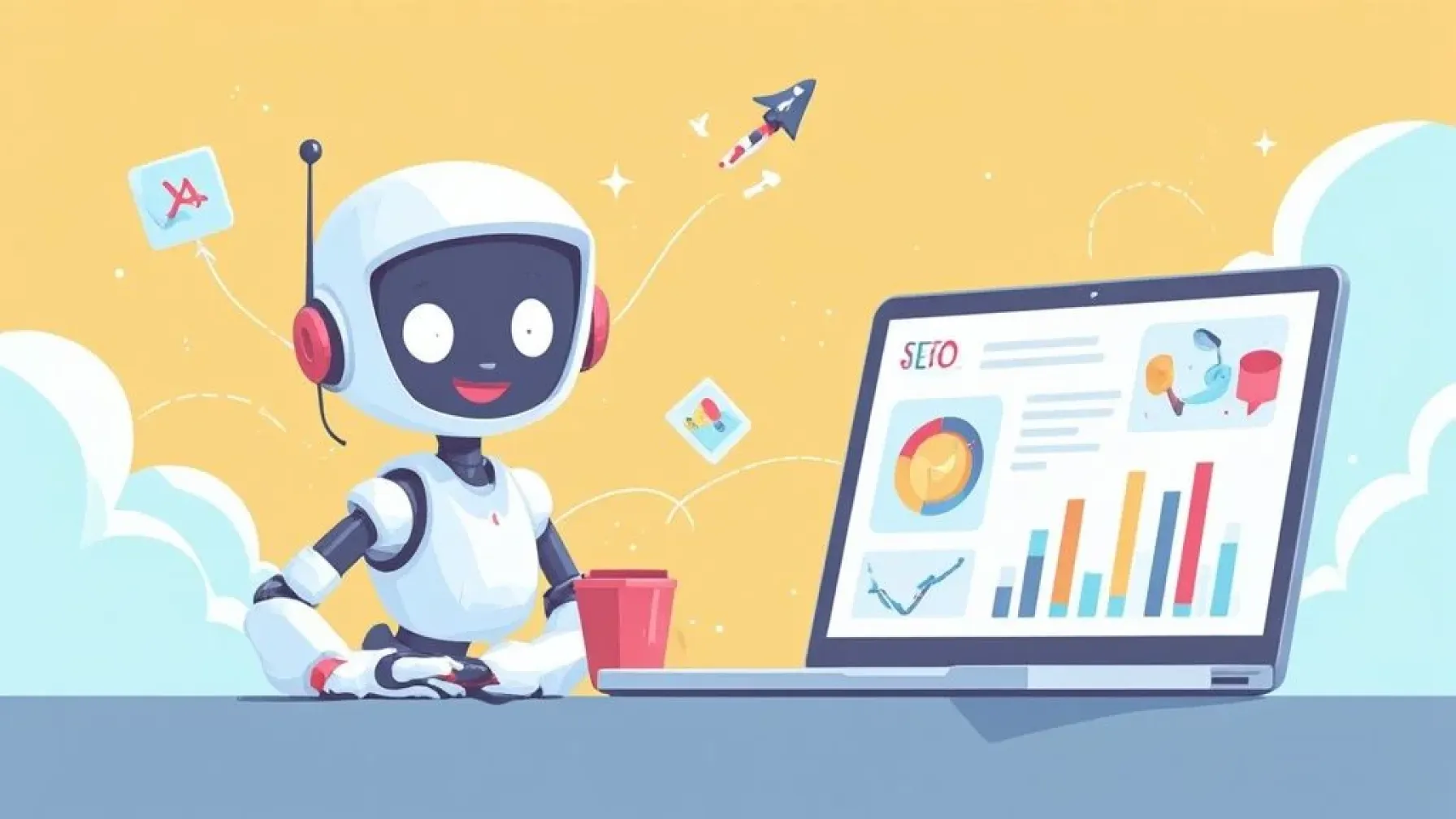
Can ChatGPT Help with SEO? A Practical Guide
Sections
- Putting ChatGPT to Work in Your SEO Strategy
- Finding Untapped Keyword Opportunities with AI
- Crafting High-Quality Content with an AI Partner
- Taking the "Technical" Out of Technical and On-Page SEO
- Weaving AI into Your Daily SEO Grind
- Navigating the Risks and Limitations of AI in SEO
- Got Questions About ChatGPT and SEO? We’ve Got Answers.
Of course. Here is the rewritten section, crafted to sound completely human-written, following the style of your provided examples.
Yes, ChatGPT can absolutely help with SEO. But let’s be clear: it’s not some magic button for a number-one ranking.
Think of it less like a self-driving car and more like a powerful co-pilot. It’s brilliant at handling the repetitive, time-sucking tasks that bog us down, but it still needs an experienced strategist - you - in the pilot’s seat to give it direction.
#Putting ChatGPT to Work in Your SEO Strategy
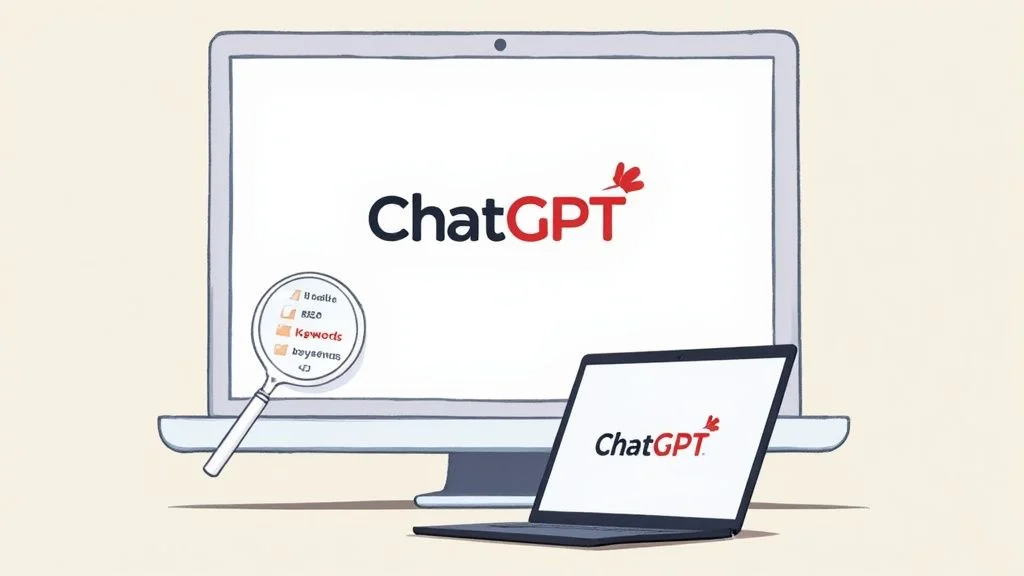
Bringing ChatGPT into your workflow is like getting a research assistant who works at the speed of light and never needs a coffee break. It processes information and follows commands instantly, freeing you up to focus on what really matters: strategy, creative thinking, and analyzing the results.
While it won’t replace the hard-won expertise of an SEO professional, it completely changes the game when it comes to efficiency. If you want to see the bigger picture, looking into the various AI applications in digital marketing can help you understand where ChatGPT fits.
To get the most out of any tool, you first need to understand the fundamentals of the job. If you’re just getting your feet wet, our beginner’s guide to search engine optimization is the perfect place to build a solid foundation.
#How ChatGPT Enhances Core SEO Tasks
Let’s take a look at how you can integrate ChatGPT into your day-to-day work. The table below offers a quick summary of how it can help with some of the most common SEO tasks.
| SEO Task | How ChatGPT Assists | Primary Benefit |
|---|---|---|
| **Content Ideation** | Generates blog topics, headlines, and content angles based on a seed keyword. | Overcomes writer's block and quickly produces a wide range of creative ideas. |
| **Keyword Research** | Creates lists of long-tail keywords, semantic variations, and question-based queries. | Speeds up the discovery process and uncovers new keyword opportunities. |
| **On-Page SEO** | Drafts meta titles, meta descriptions, and image alt text that follow best practices. | Saves significant time on repetitive optimization tasks, especially for large sites. |
| **Content Outlines** | Structures articles with logical H2 and H3 headings based on a target topic. | Builds a solid, SEO-friendly framework for content before writing begins. |
| **Technical SEO** | Generates basic Schema markup (like FAQ or How-to) and .htaccess rewrite rules. | Simplifies technical code generation for non-developers. |
As you can see, ChatGPT is especially good at speeding up the foundational work that used to take hours of manual effort. This lets you move from an idea to a finished product much faster.
By handing off these repetitive steps, your role shifts. You’re no longer just doing the work; you’re directing the AI to produce outputs that line up with your larger business goals.
The secret is to use ChatGPT practically. It’s a tool for enhancement, not a replacement for your brain. This guide will walk you through exactly how to do that, so you can improve your SEO performance without falling for the common hype-fueled mistakes.
#Finding Untapped Keyword Opportunities with AI

Keyword research is the absolute bedrock of any good SEO strategy. But let’s be honest, the old way of manually digging for terms can be a real grind. This is where AI, specifically ChatGPT, completely changes the game.
Now, it’s important to know that ChatGPT doesn’t have live search volume data like Ahrefs or Semrush. But that’s not its job. Think of it as your tireless brainstorming partner - an idea engine that helps you uncover keywords you would have otherwise missed. It’s fantastic for digging into long-tail keywords, finding different ways people phrase things, and generating question-based queries that perfectly match what your audience is actually asking.
Before you jump into using AI, make sure you’ve got a solid grasp of the basics. This guide on conducting comprehensive keyword research for SEO is a great place to start.
#Generating Specific Keyword Categories
The secret to getting gold from ChatGPT is to give it a specific role and clear instructions. Don’t just ask for “keywords.” Guide the AI to think like a seasoned expert.
Try a prompt like this:
“Act as an SEO strategist for a blog about sustainable home gardening. Generate 15 question-based, long-tail keywords that an absolute beginner would search for. Organize them by informational, commercial, and transactional intent.”
See the difference? This prompt forces ChatGPT to deliver a structured, strategic list you can actually use. It helps you map keywords directly to the different stages of your customer’s journey, from “just curious” to “ready to buy.”
#Structuring Your Keyword Research
One of the most powerful things ChatGPT can do for your SEO workflow is organize information. Once you have a raw list of keywords, you can ask it to turn that data into something immediately useful.
As a follow-up, you could ask:
“Now, take those keywords and create a table with four columns: ‘Keyword,’ ‘User Intent,’ ‘Potential Blog Title,’ and ‘Primary Target Audience.’”
With a single command, you’ve just transformed a simple list into an actionable content map. You’ve got the “what” (the keyword), the “why” (the intent), and the “how” (a blog title idea), saving you hours of tedious spreadsheet work.
This structured approach is perfect for building out topic clusters. By grouping related keywords, you can map out a comprehensive plan for a main pillar page and all its supporting articles, which is how you build real topical authority. If your goal is to own a specific niche, learning how to find low-competition keywords will make this strategy even more powerful.
When you combine your own strategic oversight with ChatGPT’s knack for rapid idea generation and organization, you build a keyword strategy that’s smarter and far more efficient than doing it all by hand.
#Crafting High-Quality Content with an AI Partner
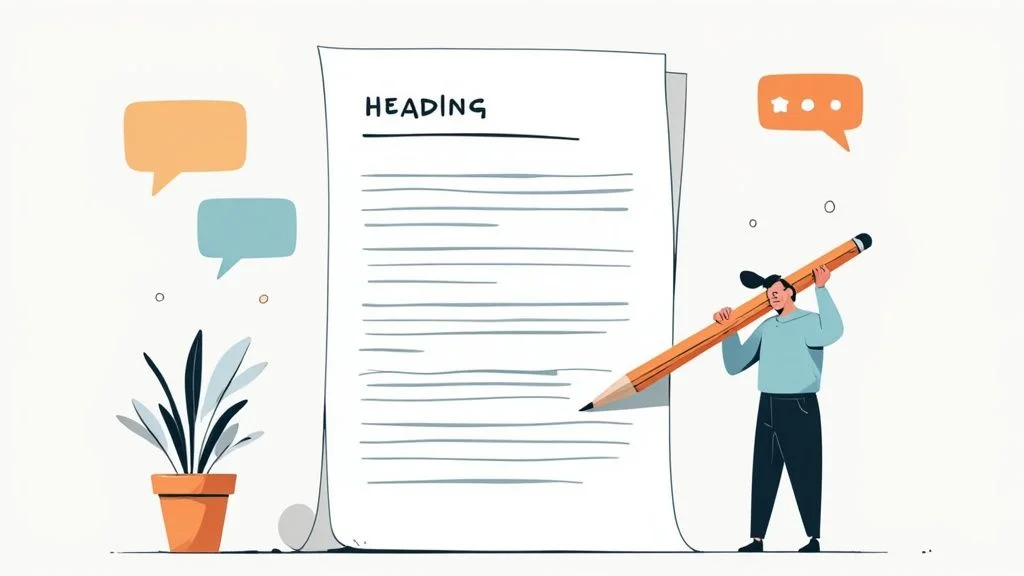
While ChatGPT is a massive help with keyword research, its real magic for SEOs shines brightest during content creation. Think of it less as a writer and more as a junior assistant - one that can build the entire skeleton of an article in seconds. This frees you up to focus on adding the muscle, the personality, and the genuine expertise that makes content truly great.
With the right approach, you can go from a vague topic to a fully-fleshed-out outline in just a few minutes. A well-thought-out prompt can generate a logical structure, complete with H2s and H3s, all designed to satisfy what the user is actually searching for. Getting this foundation right from the start makes your content a thousand times easier for both people and search engines to understand.
#Generating Your Content Framework
Here’s the thing about ChatGPT: the quality of what you get out is a direct reflection of what you put in. Vague, lazy prompts will always give you generic, lazy results. To get a solid framework, you have to be specific.
For instance, don’t just ask for “an outline about home composting.” That’s a recipe for bland, forgettable content.
Instead, try prompting it with more detail:
“Act as an expert content strategist. Create a detailed blog post outline for ‘A Beginner’s Guide to Home Composting.’ The target audience is city dwellers with small apartments or balconies. Include H2 and H3 headings. For each section, suggest key concepts to cover, like different bin types for small spaces, what you can and can’t compost in an apartment, and how to avoid common smells and pests.”
See the difference? This level of detail guides the AI to give you a structured, relevant, and genuinely helpful starting point. It can also help you whip up compelling headlines, meta descriptions, and intros that grab attention right away. From there, you can ask it to draft individual sections, but always, always treat the output as raw material, not the finished article.
#The Human-AI Collaboration Model
Let me be blunt: simply copying and pasting AI-generated text is a one-way ticket to SEO failure. It produces generic content that lacks a distinct voice and, worse, might be riddled with factual errors or AI “hallucinations.” Most importantly, it completely fails to meet Google’s standards for E-E-A-T (Experience, Expertise, Authoritativeness, and Trustworthiness).
Your job is to take the AI’s first draft and elevate it into something valuable. This is a partnership, and it requires several critical, human-led steps:
-
Fact-Checking: Verify every single statistic, claim, and piece of data. ChatGPT’s knowledge has a cutoff date and it can present outdated or just plain wrong information with unshakable confidence.
-
Injecting Expertise: This is where you shine. Add your unique insights, personal stories, and expert opinions. This is the “Experience” in E-E-A-T that only a human can bring to the table.
-
Aligning Brand Voice: Rewrite sentences to sound like you. Your content should have a consistent tone and style that reflects your brand, not a robot’s.
-
Enhancing Originality: Move paragraphs around, add new examples, and inject your personality into the text. Make it yours.
The growth of ChatGPT has been explosive - its weekly active users doubled in the first half of 2025 alone, which shows a massive shift in how people find information. To stay competitive, SEO pros need to get comfortable using AI to create foundational drafts. But the real work comes next: extensive editing to ensure authenticity and quality. You can see more data on how ChatGPT is impacting SEO workflows on Backlinko.com.
Embrace this partnership. It’s how you’ll produce high-quality, optimized content at a much faster pace without sacrificing what makes your work valuable in the first place.
#Taking the “Technical” Out of Technical and On-Page SEO
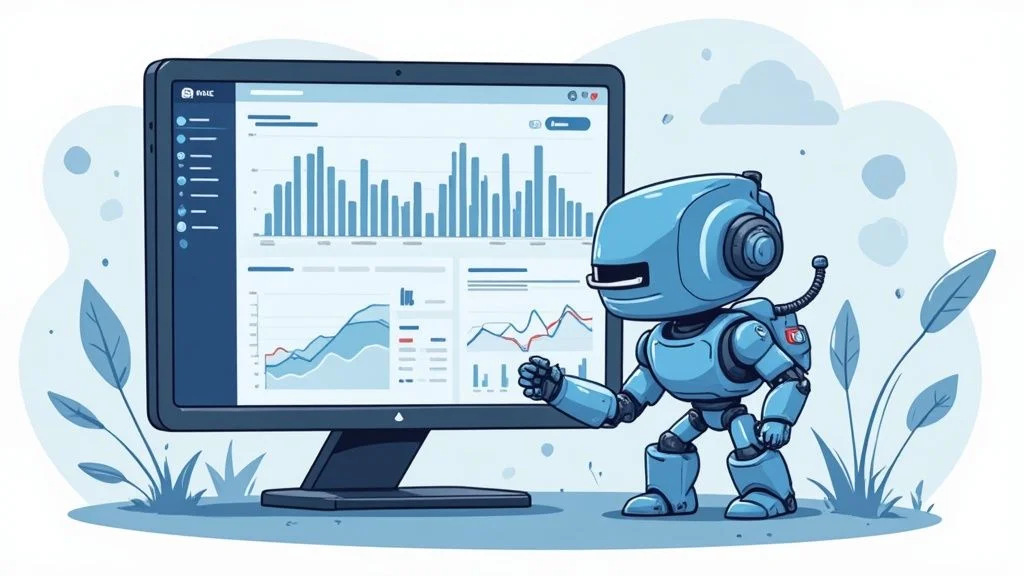
Sure, ChatGPT is a powerhouse for content, but one of its most practical uses for SEO is taming the technical beast. Let’s be honest - many of the most important on-page optimizations involve code, scripts, and rules that can make a marketer’s head spin.
Think of ChatGPT as your personal developer-translator. You give it a simple request in plain English, and it spits back the functional code you need. This is a game-changer for saving time and, more importantly, avoiding those tiny manual errors that can accidentally tank your site’s visibility.
#Generating Structured Data Markup in Seconds
Structured data, also known as schema markup, is a bit of code you add to your page to help search engines understand your content on a deeper level. Get it right, and Google might reward you with rich snippets in the search results - things like star ratings, event details, or those handy FAQ dropdowns. These can seriously boost your click-through rate.
The catch? Writing the JSON-LD script for schema can be a real pain. With ChatGPT, you can skip the manual labor completely.
Prompt Example
“Create valid FAQPage schema markup in JSON-LD format for the following three questions and answers. Make sure the output is a single, ready-to-use code block.”
-
Q: What is the best season to plant tomatoes? A: The best season is late spring, after the last frost.
-
Q: How often should I water my tomato plants? A: Water them deeply 1-2 times per week, depending on the heat.
-
Q: Do tomatoes need a lot of sun? A: Yes, they require at least 6-8 hours of direct sunlight daily.
The AI will generate the exact script you need. Just copy, paste, and add it to your page’s HTML. The same logic works for other schema types like Article, Recipe, or LocalBusiness. If you’re looking for more optimization ideas, this on-page SEO checklist is a great place to spot more opportunities for structured data.
#Writing and Debugging Critical Site Files
Beyond schema, ChatGPT is your new best friend for managing the crucial files that tell search engines how to crawl and interpret your site. These tasks used to be walled off, reserved only for those who could code. Not anymore.
Here’s how it simplifies things:
-
Creating
robots.txtRules: Need to keep a specific bot out or stop Google from crawling a private folder? Just tell ChatGPT what you want. For example: “Write arobots.txtrule to disallow all crawlers from accessing my/private-media/directory.” -
Generating
.htaccessRedirects: If you need to set up a 301 redirect from an old URL to a new one, just ask. “Create the.htaccessrewrite rule to permanently redirect/old-service-pageto/new-service-page.” -
Building Complex Regex: Regular Expressions (Regex) are incredibly useful for filtering data in tools like Google Search Console, but the syntax is notoriously tricky. Instead of wrestling with it, just ask: “Generate a regex for Google Search Console that includes URLs containing either ‘seo-guide’ or ‘keyword-tips’.”
By turning your strategic goals into technical code, ChatGPT gives you the confidence to handle advanced on-page and technical SEO tasks without needing a programming background.
#Weaving AI into Your Daily SEO Grind
It’s one thing to use ChatGPT for a random task here and there. It’s another thing entirely to build a real, AI-powered system that works for you every single day. This is about creating a rhythm where the AI handles the grunt work, freeing you up to focus on big-picture strategy and analysis.
Think of it like an assembly line. ChatGPT can be the station that sorts all your raw materials (keywords), puts together the initial frame (outlines), and preps the individual parts (drafts). Your job shifts from doing all the manual labor to being the quality control chief and strategic director, making sure the final product is perfect. This isn’t just about speed; it’s about changing your job to focus on what humans are best at: critical thinking.
#Building an AI-Assisted Content Pipeline
A smart way to start is by mapping out your content creation process and giving your AI partner specific jobs at each stage. This creates a repeatable workflow that keeps things efficient and the quality high.
Here’s what a sample week might look like:
-
Monday (Ideas & Keyword Clustering): Use ChatGPT to brainstorm a whole month’s worth of content ideas based on your main topics. You can feed it your messy keyword lists and ask it to group them into tight, logical clusters that are perfect for building out pillar pages.
-
Tuesday (Outlines & Briefs): Pick a high-priority cluster and have ChatGPT generate a detailed content brief for the main article. Be specific. Tell it the target audience, the key questions it needs to answer, and the headings (H2s and H3s) you want.
-
Wednesday (Drafting & Writing): Now, ask ChatGPT to draft the individual sections of your article based on the brief you created. To make this even faster, you can try different methods for giving it instructions, like integrating speech-to-text with ChatGPT to just talk out your commands.
-
Thursday (The Human Touch): This is the most important day. Take that AI-generated draft and pour your expertise into it. Add your brand’s voice, unique insights, and personal stories. Fact-check everything and make sure the content lives up to E-E-A-T standards.
-
Friday (Promote & Repurpose): Once the article is live, put ChatGPT back to work creating promotional content. Ask it to spin up some social media posts, snippets for your email newsletter, or even a script for a short video based on the final piece.
When you adopt this kind of model, your role fundamentally changes. You stop being just a content creator and become a content strategist. You’ll spend less time on the nuts and bolts of writing and more on the strategic stuff - like analyzing competitors and coming up with creative angles - that actually moves the needle.
The efficiency gains here are no joke. Some research suggests the expected productivity boost from AI in the workforce could be as high as 40%. And for companies using AI to make their customer experience better, the payoff can be even bigger, with a potential for 25% more revenue over five years. As AI becomes more common, making it a core part of your process is a serious competitive advantage. You can find more stats on AI’s impact on business at seo.com.
#Navigating the Risks and Limitations of AI in SEO
Let’s be honest: while ChatGPT is an incredible assistant, treating it like an infallible SEO guru is a fast track to trouble. To use it effectively, you have to be keenly aware of where it falls short. The biggest thing to remember is that AI models can be confidently incorrect.
These systems can invent facts, statistics, or sources out of thin air - a glitch in the matrix often called “hallucinations.” This is why rigorous human fact-checking isn’t just a suggestion; it’s a non-negotiable step in your workflow. Publishing inaccurate content doesn’t just mislead your audience, it crushes your site’s credibility and the E-E-A-T signals (Experience, Expertise, Authoritativeness, and Trustworthiness) you work so hard to build.
#The Dangers of Generic Content
Beyond getting the facts wrong, there’s another major risk: creating soulless, generic content. Leaning too heavily on AI without a strong human hand often produces text that’s just… bland. It lacks a unique brand voice, personal stories, or anything that truly connects with a reader. That kind of content gets lost in the noise and rarely stands out on a crowded search results page.
So, what’s Google’s take on all this?
Google has made its position crystal clear: they reward high-quality, helpful content, no matter how it’s made. Their focus is on the value the final piece provides to the user, not the tools used to get there. Spammy, low-effort content will get penalized, whether a human or an AI wrote it.
This puts the ball squarely in your court. The responsibility is on you to add that crucial human value. Always treat AI output as a starting point - a first draft that needs to be refined, fact-checked, and injected with your unique expertise and perspective.
#Adapting to a Changing SEO Landscape
The rise of AI is a double-edged sword for SEO. On one hand, recent analysis shows that smart, AI-driven content improvements can boost SEO rankings by an average of 49.2%. That’s a huge lift.
But on the other hand, the growing popularity of AI chatbots is predicted to cause a 25% drop in traditional organic search traffic by 2026. Why? Because users are getting answers directly in the chat interface instead of clicking through to websites. To keep up, 82% of businesses are already weaving AI deeper into their SEO strategies. You can dig into more of these AI in SEO statistics at seomator.com.
#Got Questions About ChatGPT and SEO? We’ve Got Answers.
As you start weaving AI into your SEO workflow, a few questions are bound to pop up. It’s totally normal. Getting these sorted out is key to using tools like ChatGPT responsibly and, more importantly, effectively.
Let’s clear the air on some of the most common concerns.
#Will Google Penalize My Site for Using AI Content?
This is the big one, isn’t it? The short answer is no, not if you do it right.
Google’s main concern is - and always has been - the quality and helpfulness of your content. They don’t really care how it was made. Their own guidelines say it loud and clear: high-quality content gets rewarded, whether it was written by a human, an AI, or a human-AI team-up.
Where you run into trouble is using AI to churn out mountains of low-effort, spammy junk. As long as you’re using ChatGPT as a creative partner to produce valuable, accurate, and human-polished articles that actually help the reader, you’re playing right by Google’s rules.
#Does ChatGPT Replace Tools Like Ahrefs or Semrush?
Absolutely not. Think of ChatGPT as a brilliant assistant, not a replacement for your core SEO toolkit.
Your dedicated SEO tools like Ahrefs and Semrush are your source for real-time, proprietary data. They give you the hard numbers on search volume, keyword difficulty, backlink profiles, and what your competitors are up to. ChatGPT has zero access to that kind of live, dynamic information.
The magic happens when you combine them. Use your pro tools to get the data, then feed that data to ChatGPT to help you make sense of it - like clustering keywords or drafting an outline based on your research.
#How Can I Make Sure My AI-Assisted Content Is Actually Unique?
Simple: never, ever hit “publish” on raw AI output. Treat everything ChatGPT gives you as a first draft. The real value, the stuff that makes content stand out, comes from you.
To make it truly yours, you need to roll up your sleeves and:
-
Add your personal insights and inject your unique brand voice.
-
Fact-check every claim, statistic, and piece of data. Don’t trust, verify.
-
Rewrite sentences and move paragraphs around to create a better story and flow.
-
Blend AI ideas with your own expertise and real-world experience.
It’s the human touch that turns a generic draft into a piece of authoritative content that people will trust and remember.
Ready to put these ideas into practice? Rankdigger gives you the real-world data and analytics to steer your AI-assisted SEO strategy. Stop guessing and start amplifying your efforts. Explore our platform and see what a data-first approach can do for you.
